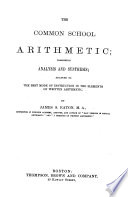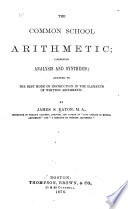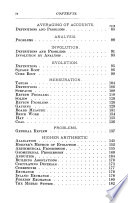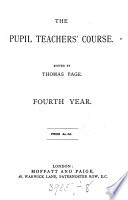 | James Stewart Eaton - Arithmetic - 1873 - 340 pages
...upon it, from the other angles of the trapezium, 6 and 8 inches ? Ans. 140 sq. in. 389. PROBLEM 3. To find the area of a trapezoid : RULE. Multiply half the sum of the parallel sides by the altitude, and the product will be the area. 387. What it a Quadrilateral ? How... | |
 | Emerson Elbridge White - Arithmetic - 1870 - 348 pages
...altitude. 4. To find the area of any quadrilateral having two sides parallel, Multiply one half of the sum of the two parallel sides by the perpendicular distance between them. 5. To find the circumference of a circle, 1. Multiply the diameter by 3.1416. Or, 2. Divide the area... | |
 | William John Macquorn Rankine, Edward Fisher Bamber - Mechanical engineering - 1873 - 368 pages
...by a pair of parallel straight lines, and a pair of straight lines not parallel). Multiply the half sum of the two parallel sides by the perpendicular distance between them. 32. Triangle. Rule A. — Multiply the length of any one of the sides by one-half of its perpendicular... | |
 | William John Macquorn Rankine, Edward Fisher Bamber - Mechanical engineering - 1873 - 372 pages
...by a pair of parallel straight lines, and a pair of straight lines not parallel). Multiply the half sum of the two parallel sides by the perpendicular distance between them. 32. Triangle. Rule A. — Multiply the length of any one of the sides by one-half of its perpendicular... | |
 | Philotus Dean - Arithmetic - 1874 - 472 pages
...rd. 4. What is the area of a triangle whose sides are, respectively, 18, 20, and 24 inches? Art. 473. To find the area of a trapezoid. Rule. — Multiply half the sum of the parallel sides by the altitude. Í. How many square feet in a board 18 ft. long, 18 in. wide at one... | |
 | Mechanical engineering - 1874 - 1186 pages
...by 2, will be the area of the trapezium. To find the area of a trapezoid. — RULE 1. — Multiply the sum of the two parallel sides by the perpendicular distance between them, and half the product will be the area. RULE 2. — Draw a diagonal, to divide the trapezoid into two... | |
 | James Stewart Eaton - Arithmetic - 1876 - 366 pages
...upon it, from the other anglea of the trapezium, 6 and 8 inches ? Ans. 140 sq. in. 389. PKOBLEM 3. To find the area of a trapezoid : RULE. Multiply half the sum of the parallel sides by the altitude, and the product will be the area. 387. What is a Quadrilateral ? How... | |
 | Samuel Mecutchen, George Mornton Sayre - Arithmetic - 1877 - 200 pages
...5. The base of a rhomboid is 375 ft. 6 in., and the perpendicular height 40 yards; what is its area? To find the area of a trapezoid. RULE. Multiply half the sum of the parallel sides by the altitude. 1. What is the number of square feet in a trapezoid, one of the parallel... | |
 | Moffatt and Paige - 1879 - 506 pages
...Trapezoid. A trapezoid is a quadrilateral figure having two only of its sides parallel. Rule. — Multiply the sum of the two parallel sides by the perpendicular distance between them, and take half the product for the. area. C __ A D f - E --- B Proof. — Let ACDB be a trapezoid, having... | |
 | Joseph Ray - Arithmetic - 1880 - 420 pages
...II. To find the area of a triangle. Rule.— Take half the product of the base by the altitude. III. To find the area of a trapezoid. Rule. — Multiply half the sum of the parallel sides by the altitude. NOTE. — The following is demonstrated in Geometry : IV. To find the... | |
| |